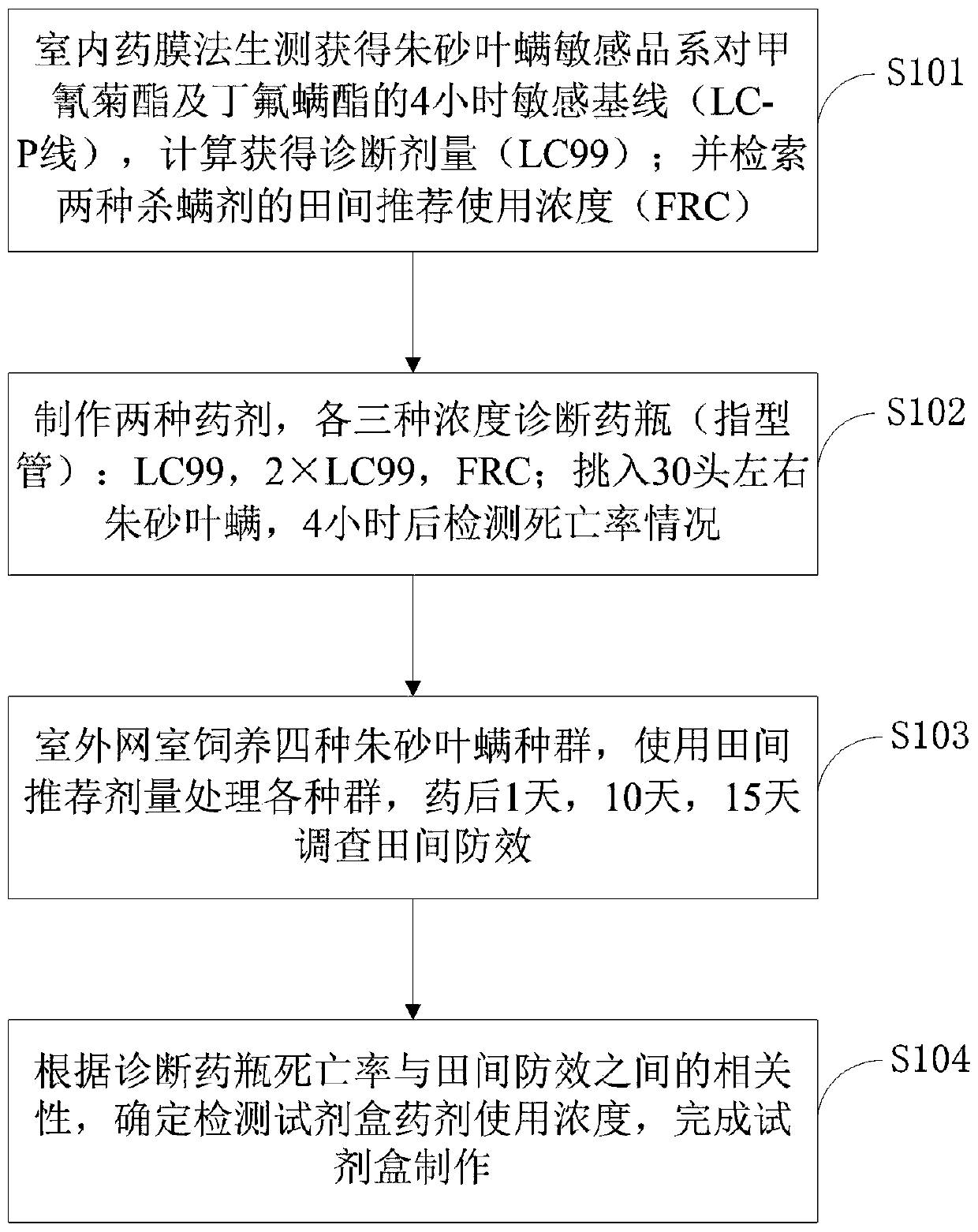Rapid field detection kit for sensitivity of tetranychidae type tiny pests and use method
A detection kit and micro-sized technology, which is applied in the field of field rapid detection kits for the sensitivity of spider mite micro-sized pests, can solve the problems of long time consumption, difficulty in obtaining and cultivating pests, and inability to meet the microscope use, etc., to achieve saving The effect of experiment cost
- Summary
- Abstract
- Description
- Claims
- Application Information
AI Technical Summary
Problems solved by technology
Method used
Image
Examples
Embodiment
[0050] 1. The source of the tested insects: a sensitive strain of Tetranychus cinnabarinus, which was obtained from indoor breeding for many years;
[0051] The Yunnan strain of Tetranychus cinnabarinus is collected from a rose garden in Yunnan that has not been sprayed for many years;
[0052] The resistant strain of Tetranychus cinnabarinus was obtained after several generations of indoor chemical screening (100.06 times of cyflumetate, 5.13w times of fenpropathrin);
[0053] They were all placed in the insect culture room of the Institute of Plant Protection, Southwest University, and raised with potted cowpea seedlings, and kept in a light incubator for a long time (temperature 26 ± 1 ° C, relative humidity 60%-80%, light L:D = 14:10h).
[0054] 2. Experimental drugs: fenpropathrin original drug (96%), cyflumetate original drug (97%)
[0055] 3. Experimental design
[0056] The 4-hour sensitive baseline (LC-P line) (LC-P line) of the sensitive strain of Tetranychus cinna...
Embodiment 1
[0089] On June 24, 2018, the sensitivity of Tetranychus cinnabarinus on cowpea in the Bishan District Experimental Base of Chongqing was detected with a field rapid detection kit, and the insects to be tested were inhaled into the drug film tube. The mortality rate was 97.2%. The test results showed that the Tetranychus cinnabarinus in this site is very sensitive to cyflumet, and the regular dose of cyflufen can be continued to control the Tetranychus cinnabarinus in this test base.
[0090] Bishan District has a large area of citrus orchards, with a high level of control and a large amount of pesticides. However, the implementation site has not used cyflufenid to control Tetranychus cinnabarinus for two consecutive years. Sensitive, you can continue to use regular doses of cyflufen to control Tetranychus cinnabarinus in this test base.
Embodiment 2
[0092] On July 15, 2018, the sensitivity of Tetranychus cinnabarinus in the vegetable garden of Shizhu County, Chongqing City was tested with a field rapid detection kit. The mortality rate was 92.3%. The test results showed that the yellow apple aphid in this area was sensitive to fenpropathrin, and regular doses of fenpropathrin could be used to control Tetranychus cinnabarinus in this test base. In fact, because the overall dosage of pesticides in the test base was very low in 2018, Tetranychus cinnabarinus has a high sensitivity to various pesticides. The current situation of pesticide application in the test field in the same year has verified the accuracy and practicability of the diagnostic kit of the present invention.
[0093] The investigation at the implementation site found that the detection results of the diagnostic kit of this embodiment coincided with the frequency and intensity of the drug administration at the detection site, further verifying the accuracy an...
PUM
 Login to View More
Login to View More Abstract
Description
Claims
Application Information
 Login to View More
Login to View More - R&D
- Intellectual Property
- Life Sciences
- Materials
- Tech Scout
- Unparalleled Data Quality
- Higher Quality Content
- 60% Fewer Hallucinations
Browse by: Latest US Patents, China's latest patents, Technical Efficacy Thesaurus, Application Domain, Technology Topic, Popular Technical Reports.
© 2025 PatSnap. All rights reserved.Legal|Privacy policy|Modern Slavery Act Transparency Statement|Sitemap|About US| Contact US: help@patsnap.com



